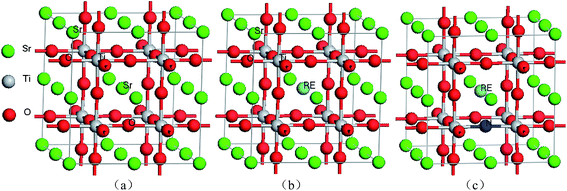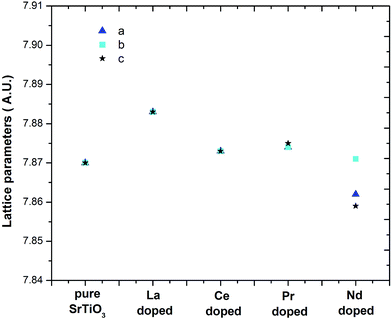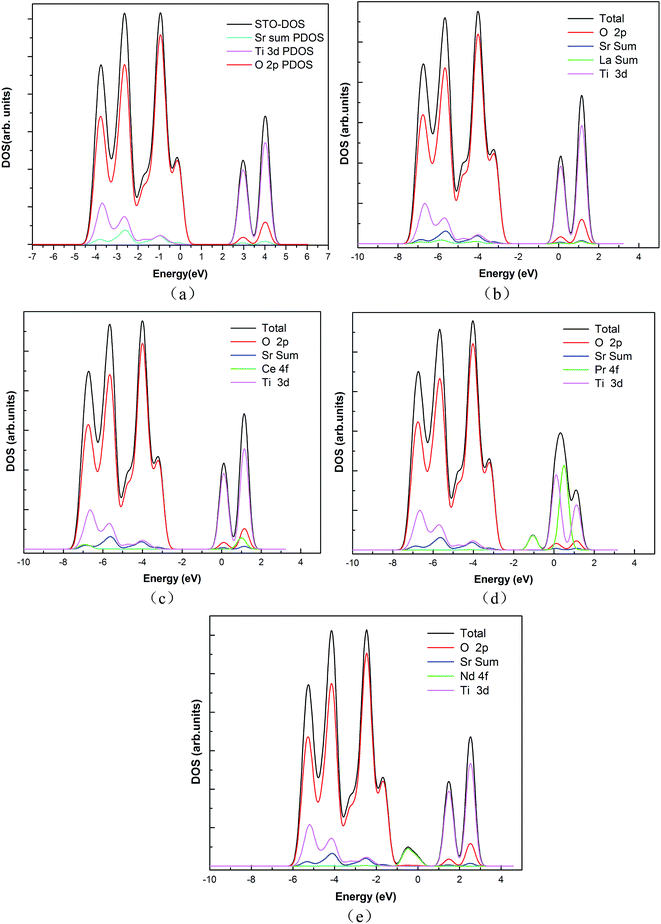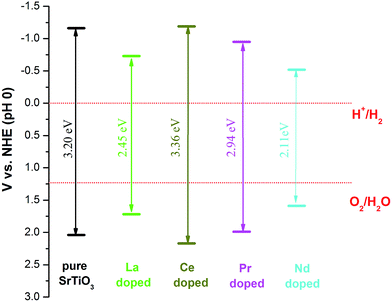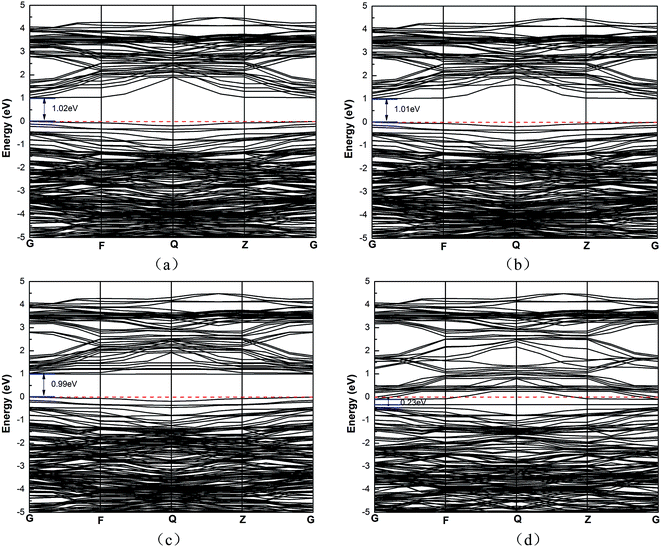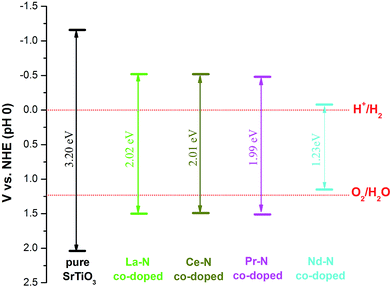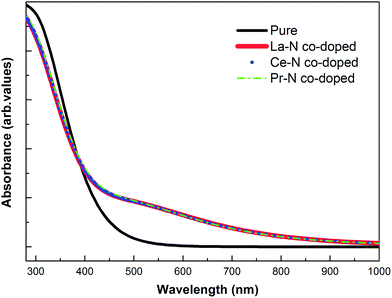 Open Access Article
Open Access ArticleCreative Commons Attribution 3.0 Unported Licence
Towards high visible light photocatalytic activity in rare earth and N co-doped SrTiO3: a first principles evaluation and prediction
Chao Zhang *a,
Nan Jianga,
Shiai Xuab,
Zheng Lia,
Xingliang Liua,
Tianle Chenga,
Aixia Hana,
Haitang Lva,
Wenliang Suna and
Yunlei Houa
*a,
Nan Jianga,
Shiai Xuab,
Zheng Lia,
Xingliang Liua,
Tianle Chenga,
Aixia Hana,
Haitang Lva,
Wenliang Suna and
Yunlei Houa
aChemical Engineering College, Qinghai University, Xining 810016, China. E-mail: zhangchaoqhu@126.com; Fax: +86-971-5310427; Tel: +86-971-5310427
bShanghai Key Laboratory of Advanced Polymeric Materials, Key Laboratory for Ultrafine Materials of Ministry of Education, School of Materials Science and Engineering, East China University of Science and Technology, Shanghai 200237, China
First published on 14th March 2017
Abstract
The band structure and photocatalytic activity of RE (La, Ce, Pr or Nd) mono-doped and RE–N co-doped SrTiO3 for band gap reduction are studied systematically using first principles calculations. Based on the evaluation methods proposed by us previously, various RE–N co-doped cases with La–N, Ce–N, Pr–N and Nd–N co-doped in SrTiO3 are studied. By comprehensive comparison, the favourable co-doping dopants are obtained and the predicted Pr–N co-doped SrTiO3 shows that it may serve as an effective potential candidate photocatalyst for water splitting under visible light among the four types of RE–N co-doped cases. In addition, the f state electrons from the RE atom may have a greater contribution to the band structure narrowing of the RE–N co-doped SrTiO3.
1. Introduction
Currently, there are numerous studies on exploiting the potential of semiconductor-based photocatalysts for water splitting and hydrogen production.1,2 As one of the typical perovskites, SrTiO3 has been extensively studied for its potential application in this area.3–5 However, due to the wide band gap (about 3.2 eV) of SrTiO3, it shows a poor response on its exposure to visible light.6 Currently, several researchers are trying to obtain substantially more sunlight by narrowing the band gap of SrTiO3. A common strategy for band gap reduction is to dope SrTiO3 structures with various cations or anions.7–11 Since mono-doping may cause compensating defects, co-doping has been proposed to overcome these limitations in SrTiO3.12–17There have been numerous reports on transition metal ion or noble metal dopants with non-metal co-doping on SrTiO3 previously. However, the rare-earth with non-metal co-doped SrTiO3 and their photocatalytic properties have seldom been reported thus far. Only a few research studies mention this topic. Wei et al.18 reported that the donor–acceptor pair recombination by co-doping could maintain the charge balance and promote the photogenerated carriers efficiency for N–La co-doped SrTiO3 under visible light. Wang et al.19 reported co-doping (N–La, C–Ce, and N–Ce–N) on the electronic structure of SrTiO3 and found that (N–Ce–N) co-doping can significantly narrow the band gap of SrTiO3. Dawson et al.20 reported the defect chemistry of RE mono-doped SrTiO3/CaTiO3/BaTiO3 and found that RE doping is energetically preferred in BaTiO3 and least favourable in SrTiO3.
Recently, the rare earths have attracted great attention with TiO2 and have shown their importance in the TiO2 matrix due to their incompletely occupied 4f and empty 5d states.21 The photocatalytic activity of TiO2 is improved by rare earth (RE) doping and the high oxidation states of RE ions may serve as efficient electron traps.22–25 Inspired by this, we think that it is necessary to systematically study the electronic structure and band edge of SrTiO3 doped with RE elements or co-doped with RE and non-metals. In addition, since the RE elements have similar ionic radii and complex 4f or 5d electrons, it is a great challenge to accurately calculate their electronic structure and predict the best co-doping properties.
Herein, we present a comparative study on the electronic structure and photocatalytic activity of RE and N co-doped SrTiO3 with RE (La, Ce, Pr or Nd) as a donor and N as an acceptor for band gap reduction. By combining the evaluation methods proposed by us previously,26 we pick the best co-doping dopant among the listed four co-doped cases via systematic evaluation and prediction. Moreover, the band structure of the chosen Pr–N co-doped SrTiO3 shows that it may be a good candidate photocatalyst for water splitting under visible light.
2. Computational methods
Herein, all the calculations carried out were performed via density functional theory (DFT) using the CASTEP code.27 The PBE function within GGA was used. The valence electrons and ionic core interaction were calculated by the Perdew–Wang 91 gradient-corrected functional28 and ultra-soft pseudo-potentials.29 The cut-off energy (Ecut) was set at 390 eV and a 2 × 2 × 2 Monkhorst–Pack30 k-mesh was adopted. The energy convergence was set to 5 × 10−5 eV per atom. The largest force on atoms was set at 0.1 eV Å−1 for convergence and criterion optimization. The stress was less than 0.2 GPa, and the maximum displacement was 5 × 10−4 nm. For the doping cases, a 2 × 2 × 2 SrTiO3 supercell with 40 atoms was used. N atom for O atom and RE (La, Ce, Pr or Nd) atom for Sr atom substitution was used in the SrTiO3 structure to model the N or RE mono-doping case. In the case of co-doping, we introduced both N and RE atoms in the SrTiO3 crystal structure with an N atom for O and RE atom for Sr in the same super structure to model the La–N, Ce–N, Pr–N and Nd–N co-doping. The chosen valence electronic configurations were 4s, 4p and 5s for Sr, 4s and 3d for Ti, 2s and 2p for O, 2s and 2p for N, 5s, 5p, 5d and 6s for La, 4f1, 5s2, 5p6, 5d1 and 6s2 for Ce, 4f3, 5s2, 5p6 and 6s2 for Pr, and 4f4, 5s2, 5p6 and 6s2 for Nd. The DFT + U formalism31,32 was employed for the accurate treatment of the correlated f or d electron phenomena with U = 6.0 eV.283. Results and discussion
3.1. RE mono-doping in SrTiO3
In order to obtain the formation energy needed for the different mono doped cases, the doping formation energy (Ef) of the different mono-doped cases was calculated according to the listed formulas and the results are shown in Table 1.
| Ef = EN-doped − (Eun-doped − μO + μN) | (1) |
| Ef = ELa(Ce/Pr/Nd)-doped − [Eun-doped − μSr + μLa (or μCe/μPr/μNd)] | (2) |
| Dopant | Ef (eV) | Eg (eV) | Eg with scissor operator (1.0 eV) |
|---|---|---|---|
| Pure | — | 2.20 | 3.20 |
| La@Sr | −0.25 | 1.45 | 2.45 |
| Ce@Sr | −1.17 | 2.36 | 3.36 |
| Pr@Sr | −1.16 | 1.94 | 2.94 |
| Nd@Sr | −1.04 | 1.11 | 2.11 |
The Ef defines the energy of the mono or co-doped dopants in SrTiO3, and Eun-doped, EN-doped, ELa-doped, ECe-doped, EPr-doped, ENd-doped, are the total energies of the SrTiO3 without doping and with N doping, La doping, Ce doping, Pr doping, and Nd doping, respectively. μO and μN are the energies of the O and N atom gained from the energies of the O2 and N2 molecular orbitals, respectively. μSr, μTi, μLa, μCe, μPr and μNd are calculated from the bulk Sr (gamma-strontium),34 Ti (alpha-titanium),35 La (hcp, structure),36 Ce (hcp, structure),36 Pr (hcp, structure),36 and Nd (hcp, structure) crystals, respectively.
The smaller the defect formation energy needed, the more favourable the substitution for the dopant. From Table 1, the result shows that the formation energy of La@Sr is −0.25 eV, which is much larger than that of Ce@Sr, Pr@Sr or Nd@Sr. This is reasonable since the ionic radius of La3+ (0.115 nm) is larger than that of Ce3+ (0.103 nm), Pr3+ (0.101 nm) or Nd3+ (0.100 nm), which leads to the relative larger formation energy of Sr substituted by La.
The calculated lattice parameters (supercell) of the different RE mono-doped SrTiO3 are shown in Fig. 2. From the lattice parameters trend we may conclude that La is energetically unfavourable compared with the Ce, Pr or Nd mono-doped cases, which is consistent with the changing trend of the defect formation energy or ionic radius of the four different RE mono-doped SrTiO3.
The band gap of the Pr@Sr or Nd@Sr mono-doped SrTiO3 case shows some degree of narrowing, and in the Ce@Sr mono-doped case, it shows some degree of increase compared with the pure case (Table 1). From Table 1 we can clearly see that the band gap of La (Pr or Nd) mono-doped SrTiO3 case shows some kind of narrowing, whereas in the Ce mono-doped SrTiO3 case, it tends to slightly increase.
In order to describe the oxidation and reduction power of the RE mono-doped SrTiO3, the valence band (VB) bottoms (EVB) and conduction band (CB) bottoms (ECB) were calculated empirically according to formula (3).37 Moreover, the suitable band edge of the catalyst should lie between the water reduction and oxidation potential, which means that the conduction band edge should lie at a potential more negative than the water reduction potential (<0 V vs. NHE at pH 0).
 | (3) |
The calculated ECB of pure, La mono-doped, Ce mono-doped, Pr mono-doped and Nd mono-doped SrTiO3 are −1.16, −0.73, −1.19, −0.95, and −0.52 eV, respectively. Thus, the VB tops are 2.04, 1.72, 2.17, 1.99 and 1.59 eV, respectively. From the calculated ECB and EVB in Fig. 4, we conclude that the four types of RE mono-doped SrTiO3 meet the requirements for water reduction without considering their efficiency, where the La (Pr or Nd) mono-doped case may be the best choice.
3.2. RE co-doping in SrTiO3
| Ef = ELa(Ce/Pr/Nd)–N-co-doped − [Eun-doped − μO − μSr + μN + μLa(or μCe/μPr/μNd)] | (4) |
The calculated atomic structures of the different RE–N co-dopings on SrTiO3 are shown in Fig. 1(c) and the lattice parameters (supercell) of the different RE–N co-doped SrTiO3 are listed in Table 2.
| Dopant | Ef (eV) | Eb (eV) | Eg (eV) | Eg with scissor operator (1.0 eV) |
|---|---|---|---|---|
| Pure | — | — | 2.20 | 3.20 |
| La–N co-doped | 8.27 | 1.84 | 1.02 | 2.02 |
| Ce–N co-doped | 3.36 | 1.34 | 1.01 | 2.01 |
| Pr–N co-doped | 2.49 | 1.91 | 0.99 | 1.99 |
| Nd–N co-doped | 3.35 | 1.11 | 0.23 | 1.23 |
From Table 2, it can be seen that the obtained formation energy of the La–N co-doped case is much larger than the other three Ce(Pr/Nd)–N co-doped cases. The change trend is similar to that of the RE mono-doped case.
For the RE–N co-doping cases, the binding energy should also be considered, which can describe the coupling strength of the RE–N co-doping cases. The defect pair binding energies were calculated according to the formula mentioned by Wei et al.18 The obtained binding energies are 1.84 eV, 1.34 eV, 1.91 eV and 1.11 eV for La–N, Ce–N, Pr–N and Nd–N co-doped SrTiO3. This, La–N and Pr–N may be more stable for SrTiO3 co-doping just from this point of view.
The lattice parameters (supercell) of the different RE–N co-doped SrTiO3 were also calculated, and the result is shown in Fig. 5. From the calculated result it can be seen that the lattice parameter a has a larger change than that of b or c, which is different from that of the RE mono-doped cases. This type of difference mainly originates from the N substitution for the O site, which also means that this type of substitution is more difficult than the RE substitution for the Sr site.
We also calculated the total DOS and PDOS for the RE–N co-doped SrTiO3, as shown in Fig. 7. From the PDOS of Ce or Pr–N co-doped SrTiO3, we find that the N 2p states form an effective complementarity with that of the Ce or Pr 4f states, which can effectively reduce the band gap (shown in Fig. 7(c and d)). However, the band structure almost tends to have conductor character for the Nd–N co-doped case, which may be due to the fact that the energy of the complete 4f states just falls between the VB and CB of SrTiO3 after the co-doping (shown in Fig. 7(d)).
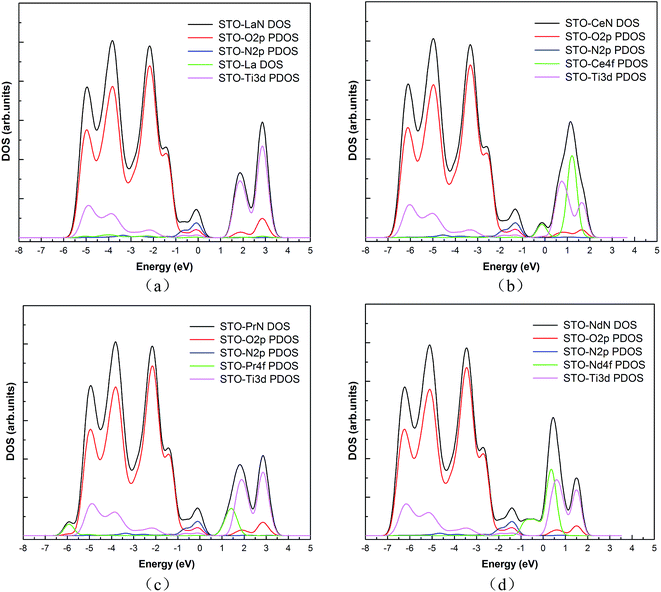 | ||
| Fig. 7 Calculated DOS and PDOS for (a) La–N co-doped SrTiO3, (b) Ce–N co-doped SrTiO3, (c) Pr–N co-doped SrTiO3, and (d) Nd–N co-doped SrTiO3. The VBM of pure SrTiO3 is chosen as the energy zero. | ||
The band gap of the RE–N co-doped SrTiO3 can be seen in Table 2. It is clear that the four types of RE–N co-doped SrTiO3 cases all tend to have a narrowing trend compared with that of pure SrTiO3, which is different from that of the RE mono-doped cases. This difference indicates that the RE–N co-doped cases may have a greater impact on the band gap compared with that of the RE mono-doped cases, and thus RE–N co-doping may be a better strategy.
It is difficult to select a suitable RE–N co-doping from the abovementioned four types of co-doping cases just from the value of the band gap; we also have to consider the precise band edge of the valence band (VB) bottoms (EVB) and conduction band (CB) bottoms (ECB) of the co-doped case. Thus, the EVB and ECB of the RE–N co-doped cases were calculated also using formula (3).
The calculated ECB of the La–N co-doped, Ce–N co-doped, Pr–N co-doped and Nd–N co-doped SrTiO3 were −0.52, −0.52, −0.48 and −0.08 eV, respectively, and thus the VB tops were 1.50, 1.49, 1.51 and 1.15 eV, respectively. The precise band edges of the EVB and ECB of La–N, Ce–N, Pr–N and Nd–N co-doped SrTiO3 are shown in Fig. 8. From the obtained ECB and EVB, we could deduce that the band edges of La–N, Ce–N and Pr–N co-doped SrTiO3 are located just out of the NHE potential and could well meet the requirements for water splitting and hydrogen production.
3.3. Prediction and picking the favorable RE–N co-doping dopants on SrTiO3
As described before, it is insufficient to predict one RE–N co-doping case from the given La–N, Ce–N, Pr–N or Nd–N co-doping systems as the best candidate. Based on the three basic rules proposed by us previously,26 we choose the best co-doping dopant among the listed four co-doped cases via systematic evaluation and prediction. By comprehensively combining the band gap, the precise band edge of EVB and ECB, the formation energy and binding energy of the different RE–N co-doping cases, the Pr–N co-doped dopant may be a good potential candidate for the co-doping of SrTiO3 among the La–N, Ce–N, Pr–N and Nd–N co-doped cases, which may serve as an effective potential candidate photocatalyst.4. Conclusion
We present a comparative calculation on the electronic structure and photocatalytic of RE (La, Ce, Pr or Nd)–N co-doped SrTiO3 for band gap reduction. Based on the evaluation methods proposed by us previously, various types of RE–N co-doping cases with La–N, Ce–N, Pr–N and Nd–N co-doped in SrTiO3 are studied. The obtained favourable co-doping dopant and the predicted Pr–N co-doped SrTiO3 shows that it may serve as an effective potential candidate photocatalyst for water splitting under visible light among the four RE co-doped cases. In addition, the f state electrons from the RE atom may have a greater contribution to the band structure narrowing of the RE–N co-doped SrTiO3.Acknowledgements
This study is financially supported by the Natural Science Foundation of QingHai Science & Technology Department (2016-ZJ-946Q). The Computer Network Information Center (CNIC) is also acknowledged for high-performance computing services.References
- B. Modak, K. Srinivasu and S. K. Ghosh, Improving photocatalytic properties of SrTiO3 through (Sb, N) codoping: a hybrid density functional study, RSC Adv., 2014, 4(86), 45703–45709 RSC.
- X. Chen, S. Shen, L. Guo and S. S. Mao, Semiconductor-based photocatalytic hydrogen generation, Chem. Rev., 2010, 110(11), 6503–6570 CrossRef CAS PubMed.
- P. Reunchan, S. Ouyang, N. Umezawa, H. Xu, Y. Zhang and J. Ye, Theoretical design of highly active SrTiO3-based photocatalysts by a codoping scheme towards solar energy utilization for hydrogen production, J. Mater. Chem. A, 2013, 1, 4221–4227 CAS.
- S. Hara, M. Yoshimizu, S. Tanigawa, L. Ni, B. Ohtani and H. Irie, Hydrogen and oxygen evolution photocatalysts synthesized from strontium titanate by controlled doping and their performance in two-step overall water splitting under visible light, J. Phys. Chem. C, 2012, 116, 17458–17463 CAS.
- Q. Fu, T. He, J. L. Li and G. W. Yang, Band-engineered SrTiO3 nanowires for visible light photocatalysis, J. Appl. Phys., 2013, 113, 104303 CrossRef.
- M. Batzill, E. H. Morales and U. Diebold, Influence of nitrogen doping on the defect formation and surface properties of TiO2 rutile and anatase, Phys. Rev. Lett., 2006, 96, 26103 CrossRef PubMed.
- W. Wei, Y. Dai, H. Jin and B. B. Huang, Density functional characterization of the electronic structure and optical properties of Cr-doped SrTiO3, J. Phys. D: Appl. Phys., 2009, 42, 055401 CrossRef.
- H. Irie, Y. Maruyama and K. Hashimoto, Ag+- and Pb2+-Doped SrTiO3 Photocatalysts: A correlation Between Band Structure and Photocatalytic Activity, J. Phys. Chem. C, 1847, 2007, 111 Search PubMed.
- R. Konta, T. Ishii, H. Kato and A. Kudo, Photocatalytic activities of noble metal ion doped SrTiO3 under visible light irradiation, J. Phys. Chem. B, 2004, 108, 8992 CrossRef CAS.
- J. Wang, S. Yin, M. Komatsu, Q. Zhang, F. Saito and T. Sato, Mechanochemical synthesis and photocatalytic activity of nitrogen doped SrTiO3, J. Ceram. Soc. Jpn., 2004, 5, S1408 Search PubMed.
- C. Zhang, Y. Z. Jia, Y. Jing, Y. Yao, J. Ma and J. H. Sun, Effect of non-metal elements (B, C, N, F, P, S) mono-doping as anions on electronic structure of SrTiO3, Comput. Mater. Sci., 2013, 79, 69 CrossRef CAS.
- U. Sulaeman, S. Yin and T. Sato, Visible light photocatalytic properties of Ta and N codoped SrTiO3 nanoparticles, Int. J. Opt., 2010, 2010, 261420 Search PubMed.
- W. J. Shi and S. Xiong, Ab initio study on band-gap narrowing in SrTiO3 with Nb–C–Nb codoping, Phys. Rev. B: Condens. Matter Mater. Phys., 2011, 84, 205210 CrossRef.
- H. Liu, H. Dong and F. Wu, First-principles study on strontium titanate for visible light photocatalysis, Chem. Phys. Lett., 2013, 555, 141 CrossRef CAS.
- J. Wang, H. Li, S. Yin and T. Sato, Synthesis of La/N co-doped SrTiO3 using polymerized complex method for visible light photocatalysis, Solid State Sci., 2009, 11, 182 CrossRef CAS.
- C. Zhang, Y. Z. Jia, Y. Jing, Y. Yao, J. Ma and J. H. Sun, DFT study on electronic structure and optical properties of N-doped, S-doped, and N/S co-doped SrTiO3, Phys. B, 2012, 407, 4649 CrossRef CAS.
- P. Liu, J. Nisar, B. Pathak and R. Ahuja, Hybrid density functional study on SrTiO3 for visible light photocatalysis, Int. J. Hydrogen Energy, 2012, 37, 11611 CrossRef CAS.
- W. Wei, Y. Dai, M. Guo, L. Yu and B. B. Huang, Density functional characterization of the electronic structure and optical properties of N-doped, La-doped, and N/La-codoped SrTiO3, J. Phys. Chem. C, 2009, 113, 15046 CAS.
- C. Wang, H. Qiu, T. Inoue and Q. Yao, Highly active SrTiO3, for visible light photocatalysis: a first-principles prediction, Solid State Commun., 2014, 181, 5–8 CrossRef CAS.
- J. A. Dawson, X. Li, C. L. Freeman, J. H. Harding and D. C. Sinclair, The application of a new potential model to the rare-earth doping of SrTiO3 and CaTiO3, J. Mater. Chem. C, 2013, 8, 1574–1582 RSC.
- A. W. Xu, G. Yuan and H. Q. Liu, The preparation, characterization, and their photocatalytic activities of rare earth doped TiO2, nanoparticles, J. Catal., 2002, 207, 151–157 CrossRef CAS.
- N. Aman, P. K. Satapathy, T. Mishra, M. Mahato and N. N. Das, Synthesis and photocatalytic activity of mesoporous cerium doped TiO2 as visible light sensitive photocatalyst, Mater. Res. Bull., 2012, 47, 179–183 CrossRef CAS.
- R. M. Mohamed and I. A. Mkhalid, The effect of rare earth dopants on the structure, surface texture and photocatalytic properties of TiO2–SiO2, prepared by sol–gel method, J. Alloys Compd., 2010, 501, 143–147 CrossRef CAS.
- H. Shi, T. Zhang, T. An, B. Li and X. Wang, Enhancement of photocatalytic activity of nano-scale TiO2, particles co-doped by rare earth elements and heteropolyacids, J. Colloid Interface Sci., 2012, 380, 121–127 CrossRef CAS PubMed.
- P. C. Ricci, A. G. Lehmann, F. Congiu, F. Spadavecchia and C. M. Carbonaro, Structure and photoluminescence of TiO2 nanocrystals doped and co-doped with N and rare earths (Y3+, Pr3+), J. Alloys Compd., 2013, 561, 109–113 CrossRef CAS.
- C. Zhang, Y. Jia, Y. Jing and Y. Yao, New insights into assessing the favorable co-doping dopants with various co-doped cases for the band gap engineering of SrTiO3, Int. J. Hydrogen Energy, 2015, 40, 1343–1351 CrossRef CAS.
- M. D. Segall, J. D. Lindan Philip, M. J. Probert, C. J. Pickard, P. J. Hasnip, S. J. Clark and M. C. Payne, First-principles simulation: ideas, illustrations and the CASTEP code, J. Phys.: Condens. Matter, 2002, 14, 2717 CrossRef CAS.
- J. P. Perdew, J. A. Chevary, S. H. Vosko, K. A. Jackson, M. R. Pederson, D. J. Singh and C. Fiolhais, Atoms, molecules, solids, and surfaces: applications of the generalized gradient approximation for exchange and correlation, Phys. Rev. B: Condens. Matter Mater. Phys., 1992, 46, 6671 CrossRef CAS.
- D. Vanderbilt, Soft self-consistent pseudopotentials in a generalized eigenvalue formalism, Phys. Rev. B: Condens. Matter Mater. Phys., 1990, 41, 7892 CrossRef.
- H. J. Monkhorst and J. D. Pack, On special points for brillouin zone integrations, Phys. Rev. B: Solid State, 1976, 13, 5188 CrossRef.
- M. C. Qian, W. Y. Hu, Q. Q. Zheng and H. Q. Lin, Electronic structure of PrBa2Cu3O7 and YBa2Cu3O7: a local spin density approximation with the on-site coulomb interaction study, J. Appl. Phys., 1999, 85, 4765–4767 CrossRef CAS.
- D. Marel and G. A. Sawatzky, Electron–electron interaction and localization in d and f transition metals, Phys. Rev. B: Condens. Matter Mater. Phys., 1988, 37, 10674 CrossRef.
- T. Mitsui, S. Nouma and B. Landolt, Numerical data and functional relation in science and technology: crystal and solid state Physics, New Series, Group 2I, Springer, Berlin, 1982 Search PubMed.
- R. G. Hirst, A. J. King and F. A. Kanda, The barium–strontium equilibrium system, J. Phys. Chem., 1956, 60, 302–304 CrossRef CAS.
- S. F. Glavatskikh and A. I. Gorshkov, Natural analog of alpha-titanium in the exhalation products of the great tolbachik fissure eruption (kamchatka), Dokl. Akad. Nauk, 1992, 327, 123–127 Search PubMed.
- R. W. G. Wyckoff, Crystal Structures, Interscience Publishers, New York, 2nd edn, 1963 Search PubMed.
- J. Lv, T. Kako and Z. Zou, Band structure design and photocatalytic activity of In2O3/N–InNbO4 composite, Appl. Phys. Lett., 2009, 95, 032107 CrossRef.
- L. J. Bartolotti, Absolute electronegativities as determined from Kohn–Sham theory, Springer, Berlin, Heidelberg, 1987, pp. 27–40 Search PubMed.
- J. Feng, B. Xiao and J. C. Chen, Optical properties of new photovoltaic materials: AgCuO2 and Ag2Cu2O3, Solid State Commun., 2009, 149, 1569 CrossRef CAS.
| This journal is © The Royal Society of Chemistry 2017 |

